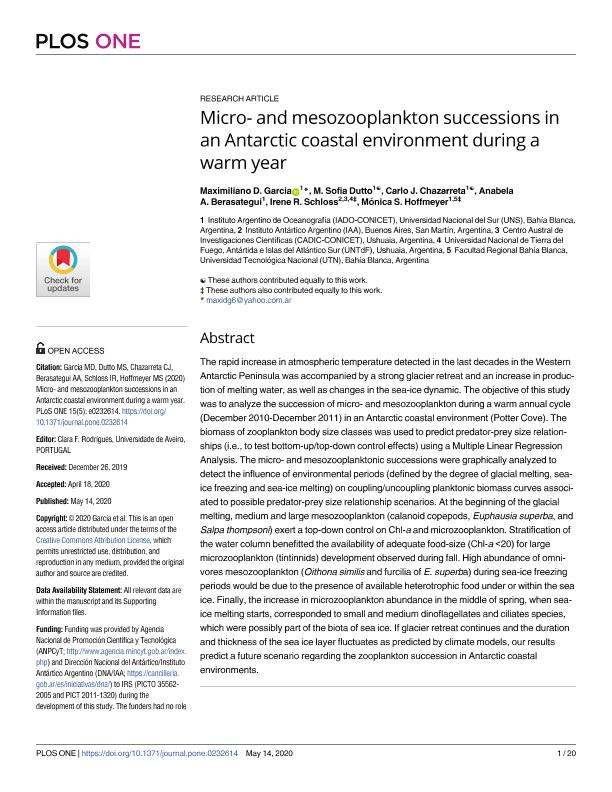Artículo
Micro- and mesozooplankton successions in an Antarctic coastal environment during a warm year
Garcia, Maximiliano Darío ; Dutto, María Sofía
; Dutto, María Sofía ; Chazarreta, Carlo Javier
; Chazarreta, Carlo Javier ; Berasategui, Anabela Anhi
; Berasategui, Anabela Anhi ; Schloss, Irene Ruth
; Schloss, Irene Ruth ; Hoffmeyer, Monica Susana
; Hoffmeyer, Monica Susana
 ; Dutto, María Sofía
; Dutto, María Sofía ; Chazarreta, Carlo Javier
; Chazarreta, Carlo Javier ; Berasategui, Anabela Anhi
; Berasategui, Anabela Anhi ; Schloss, Irene Ruth
; Schloss, Irene Ruth ; Hoffmeyer, Monica Susana
; Hoffmeyer, Monica Susana
Fecha de publicación:
14/05/2020
Editorial:
Public Library of Science
Revista:
Plos One
ISSN:
1932-6203
Idioma:
Inglés
Tipo de recurso:
Artículo publicado
Clasificación temática:
Resumen
The rapid increase in atmospheric temperature detected in the last decades in the Western Antarctic Peninsula was accompanied by a strong glacier retreat and an increase in production of melting water, as well as changes in the sea-ice dynamic. The objective of this study was to analyze the succession of micro- and mesozooplankton during a warm annual cycle (December 2010-December 2011) in an Antarctic coastal environment (Potter Cove). The biomass of zooplankton body size classes was used to predict predator-prey size relationships (i.e., to test bottom-up/top-down control effects) using a Multiple Linear Regression Analysis. The micro- and mesozooplanktonic successions were graphically analyzed to detect the influence of environmental periods (defined by the degree of glacial melting, sea-ice freezing and sea-ice melting) on coupling/uncoupling planktonic biomass curves associated to possible predator-prey size relationship scenarios. At the beginning of the glacial melting, medium and large mesozooplankton (calanoid copepods, Euphausia superba, and Salpa thompsoni) exert a top-down control on Chl-a and microzooplankton. Stratification of the water column benefitted the availability of adequate food-size (Chl-a <20) for large microzooplankton (tintinnids) development observed during fall. High abundance of omnivores mesozooplankton (Oithona similis and furcilia of E. superba) during sea-ice freezing periods would be due to the presence of available heterotrophic food under or within the sea ice. Finally, the increase in microzooplankton abundance in the middle of spring, when sea-ice melting starts, corresponded to small and medium dinoflagellates and ciliates species, which were possibly part of the biota of sea ice. If glacier retreat continues and the duration and thickness of the sea ice layer fluctuates as predicted by climate models, our results predict a future scenario regarding the zooplankton succession in Antarctic coastal environments.
Palabras clave:
MICROZOOPLANKTON
,
MESOZOOPLANKTON
,
POTTER COVE
,
ANTARCTICA
Archivos asociados
Licencia
Identificadores
Colecciones
Articulos(CADIC)
Articulos de CENTRO AUSTRAL DE INVESTIGACIONES CIENTIFICAS
Articulos de CENTRO AUSTRAL DE INVESTIGACIONES CIENTIFICAS
Articulos(IADO)
Articulos de INST.ARG.DE OCEANOGRAFIA (I)
Articulos de INST.ARG.DE OCEANOGRAFIA (I)
Citación
Garcia, Maximiliano Darío; Dutto, María Sofía; Chazarreta, Carlo Javier; Berasategui, Anabela Anhi; Schloss, Irene Ruth; et al.; Micro- and mesozooplankton successions in an Antarctic coastal environment during a warm year; Public Library of Science; Plos One; 15; 5; 14-5-2020; 1-20
Compartir
Altmétricas



